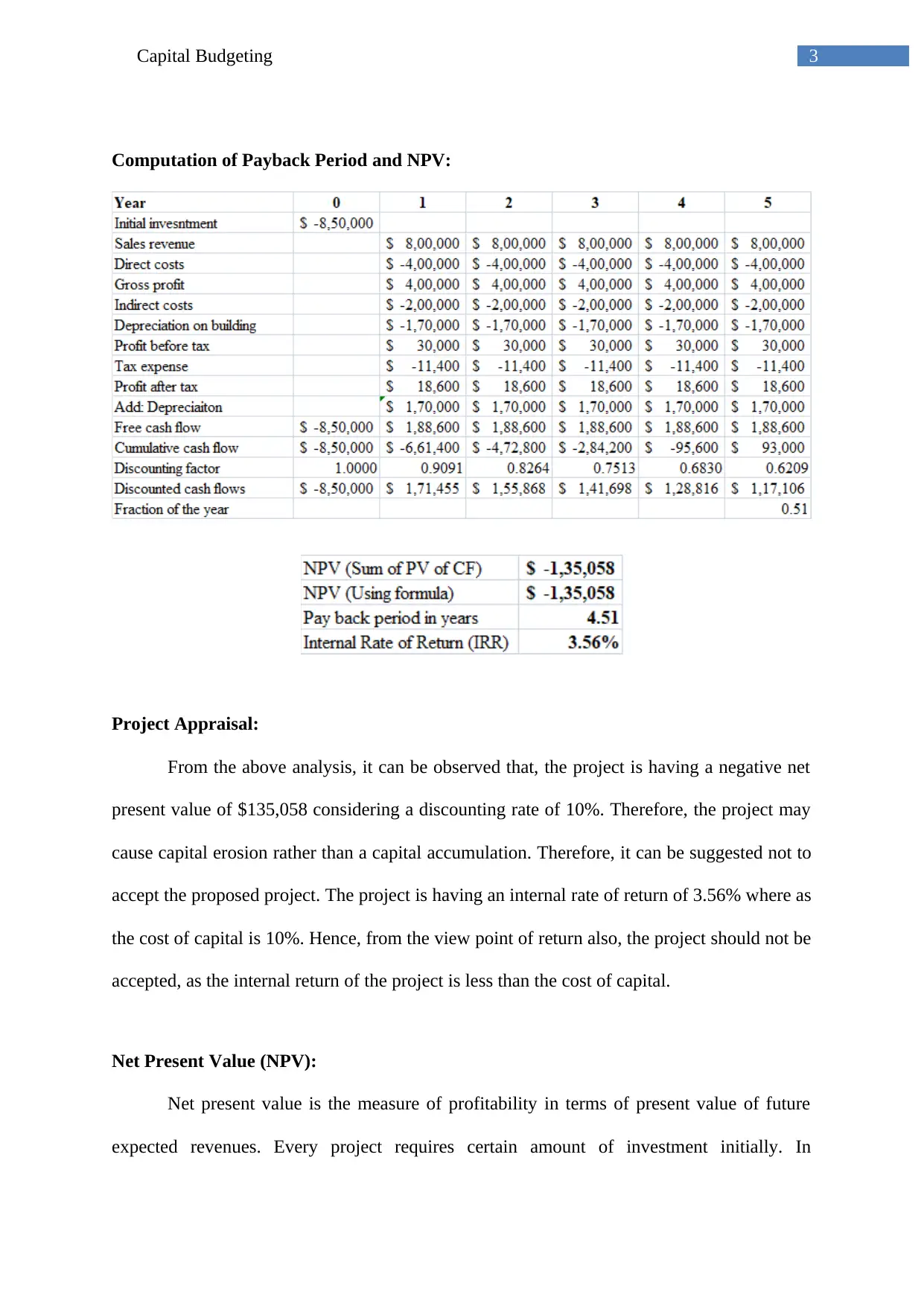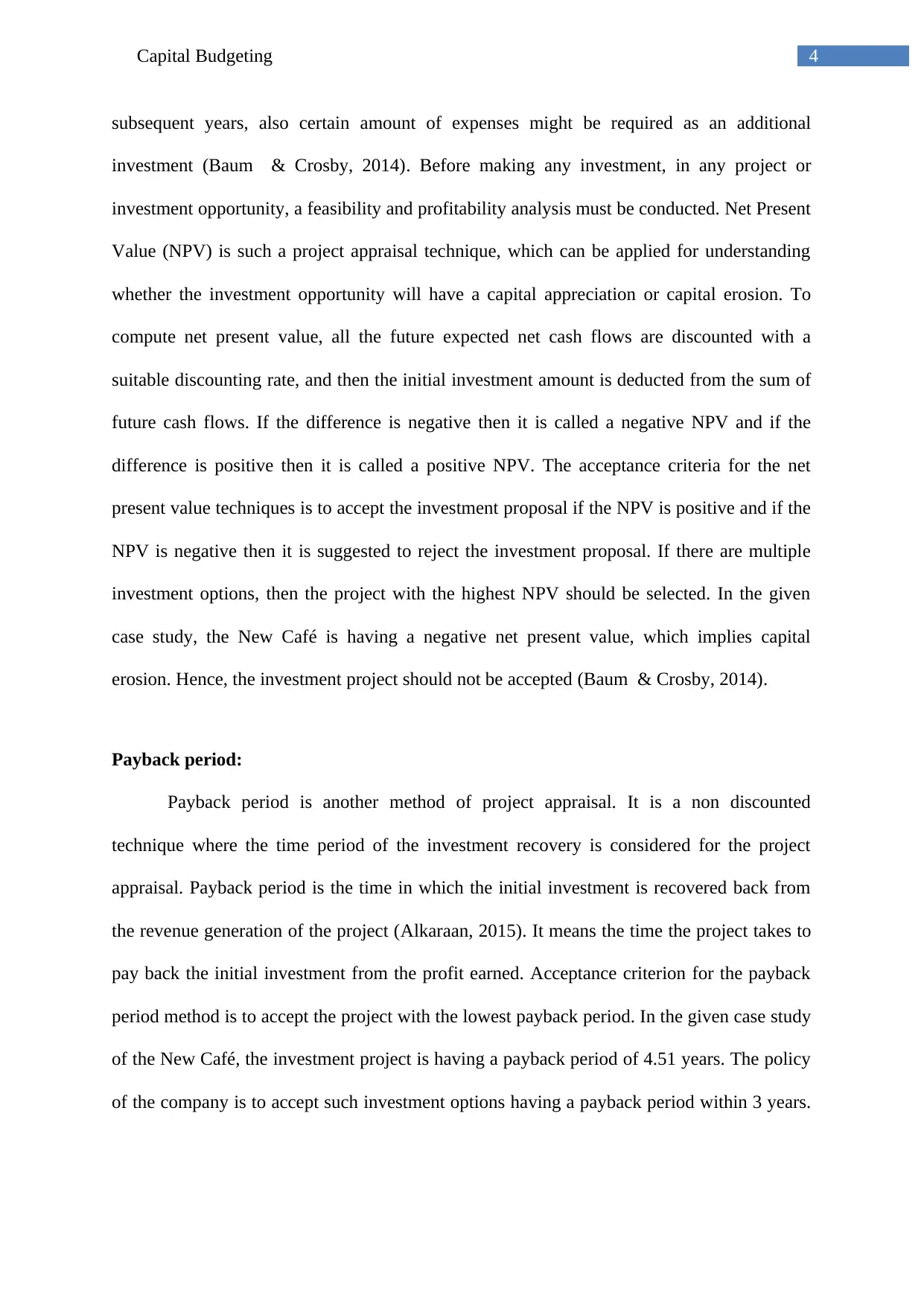Capital Budgeting Analysis: NPV, Payback Period, and Project Appraisal
VerifiedAdded on 2022/10/08
|6
|722
|45
Homework Assignment
AI Summary
This assignment provides a comprehensive analysis of capital budgeting techniques, focusing on Net Present Value (NPV) and payback period calculations. The student analyzes a project, concluding that it has a negative NPV and an extended payback period, suggesting the project should not be acc...

Running head: CAPITAL BUDGETING
Capital Budgeting
Name of the Student:
Name of the University:
Author’s Note:
Capital Budgeting
Name of the Student:
Name of the University:
Author’s Note:
Paraphrase This Document
Need a fresh take? Get an instant paraphrase of this document with our AI Paraphraser

2Capital Budgeting
Table of Contents
Computation of Payback Period and NPV:................................................................................3
Project Appraisal:.......................................................................................................................3
Net Present Value (NPV):..........................................................................................................3
Payback period:..........................................................................................................................4
References and bibliography:.....................................................................................................6
Table of Contents
Computation of Payback Period and NPV:................................................................................3
Project Appraisal:.......................................................................................................................3
Net Present Value (NPV):..........................................................................................................3
Payback period:..........................................................................................................................4
References and bibliography:.....................................................................................................6

3Capital Budgeting
Computation of Payback Period and NPV:
Project Appraisal:
From the above analysis, it can be observed that, the project is having a negative net
present value of $135,058 considering a discounting rate of 10%. Therefore, the project may
cause capital erosion rather than a capital accumulation. Therefore, it can be suggested not to
accept the proposed project. The project is having an internal rate of return of 3.56% where as
the cost of capital is 10%. Hence, from the view point of return also, the project should not be
accepted, as the internal return of the project is less than the cost of capital.
Net Present Value (NPV):
Net present value is the measure of profitability in terms of present value of future
expected revenues. Every project requires certain amount of investment initially. In
Computation of Payback Period and NPV:
Project Appraisal:
From the above analysis, it can be observed that, the project is having a negative net
present value of $135,058 considering a discounting rate of 10%. Therefore, the project may
cause capital erosion rather than a capital accumulation. Therefore, it can be suggested not to
accept the proposed project. The project is having an internal rate of return of 3.56% where as
the cost of capital is 10%. Hence, from the view point of return also, the project should not be
accepted, as the internal return of the project is less than the cost of capital.
Net Present Value (NPV):
Net present value is the measure of profitability in terms of present value of future
expected revenues. Every project requires certain amount of investment initially. In
⊘ This is a preview!⊘
Do you want full access?
Subscribe today to unlock all pages.

Trusted by 1+ million students worldwide

4Capital Budgeting
subsequent years, also certain amount of expenses might be required as an additional
investment (Baum & Crosby, 2014). Before making any investment, in any project or
investment opportunity, a feasibility and profitability analysis must be conducted. Net Present
Value (NPV) is such a project appraisal technique, which can be applied for understanding
whether the investment opportunity will have a capital appreciation or capital erosion. To
compute net present value, all the future expected net cash flows are discounted with a
suitable discounting rate, and then the initial investment amount is deducted from the sum of
future cash flows. If the difference is negative then it is called a negative NPV and if the
difference is positive then it is called a positive NPV. The acceptance criteria for the net
present value techniques is to accept the investment proposal if the NPV is positive and if the
NPV is negative then it is suggested to reject the investment proposal. If there are multiple
investment options, then the project with the highest NPV should be selected. In the given
case study, the New Café is having a negative net present value, which implies capital
erosion. Hence, the investment project should not be accepted (Baum & Crosby, 2014).
Payback period:
Payback period is another method of project appraisal. It is a non discounted
technique where the time period of the investment recovery is considered for the project
appraisal. Payback period is the time in which the initial investment is recovered back from
the revenue generation of the project (Alkaraan, 2015). It means the time the project takes to
pay back the initial investment from the profit earned. Acceptance criterion for the payback
period method is to accept the project with the lowest payback period. In the given case study
of the New Café, the investment project is having a payback period of 4.51 years. The policy
of the company is to accept such investment options having a payback period within 3 years.
subsequent years, also certain amount of expenses might be required as an additional
investment (Baum & Crosby, 2014). Before making any investment, in any project or
investment opportunity, a feasibility and profitability analysis must be conducted. Net Present
Value (NPV) is such a project appraisal technique, which can be applied for understanding
whether the investment opportunity will have a capital appreciation or capital erosion. To
compute net present value, all the future expected net cash flows are discounted with a
suitable discounting rate, and then the initial investment amount is deducted from the sum of
future cash flows. If the difference is negative then it is called a negative NPV and if the
difference is positive then it is called a positive NPV. The acceptance criteria for the net
present value techniques is to accept the investment proposal if the NPV is positive and if the
NPV is negative then it is suggested to reject the investment proposal. If there are multiple
investment options, then the project with the highest NPV should be selected. In the given
case study, the New Café is having a negative net present value, which implies capital
erosion. Hence, the investment project should not be accepted (Baum & Crosby, 2014).
Payback period:
Payback period is another method of project appraisal. It is a non discounted
technique where the time period of the investment recovery is considered for the project
appraisal. Payback period is the time in which the initial investment is recovered back from
the revenue generation of the project (Alkaraan, 2015). It means the time the project takes to
pay back the initial investment from the profit earned. Acceptance criterion for the payback
period method is to accept the project with the lowest payback period. In the given case study
of the New Café, the investment project is having a payback period of 4.51 years. The policy
of the company is to accept such investment options having a payback period within 3 years.
Paraphrase This Document
Need a fresh take? Get an instant paraphrase of this document with our AI Paraphraser

5Capital Budgeting
Hence, the new investment project for the New Café should be rejected as the payback period
of the investment option is more that their desired payback period (Alkaraan, 2015).
Hence, the new investment project for the New Café should be rejected as the payback period
of the investment option is more that their desired payback period (Alkaraan, 2015).

6Capital Budgeting
References and bibliography:
Alkaraan, F. (2015). Strategic investment decision-making perspectives. In Advances in
mergers and acquisitions (pp. 53-66). Emerald Group Publishing Limited.
Alkaraan, F. (2017). Strategic investment appraisal: multidisciplinary perspectives.
In Advances in Mergers and Acquisitions (pp. 67-82). Emerald Publishing Limited.
Baum, A. E., & Crosby, N. (2014). Property investment appraisal. John Wiley & Sons.
Illés, M. (2019). Links Between Net Present Value and Shareholder Value from a Business
Economics Perspective.
References and bibliography:
Alkaraan, F. (2015). Strategic investment decision-making perspectives. In Advances in
mergers and acquisitions (pp. 53-66). Emerald Group Publishing Limited.
Alkaraan, F. (2017). Strategic investment appraisal: multidisciplinary perspectives.
In Advances in Mergers and Acquisitions (pp. 67-82). Emerald Publishing Limited.
Baum, A. E., & Crosby, N. (2014). Property investment appraisal. John Wiley & Sons.
Illés, M. (2019). Links Between Net Present Value and Shareholder Value from a Business
Economics Perspective.
⊘ This is a preview!⊘
Do you want full access?
Subscribe today to unlock all pages.

Trusted by 1+ million students worldwide
1 out of 6
Related Documents
Your All-in-One AI-Powered Toolkit for Academic Success.
+13062052269
info@desklib.com
Available 24*7 on WhatsApp / Email
![[object Object]](/_next/static/media/star-bottom.7253800d.svg)
Unlock your academic potential
© 2024 | Zucol Services PVT LTD | All rights reserved.





